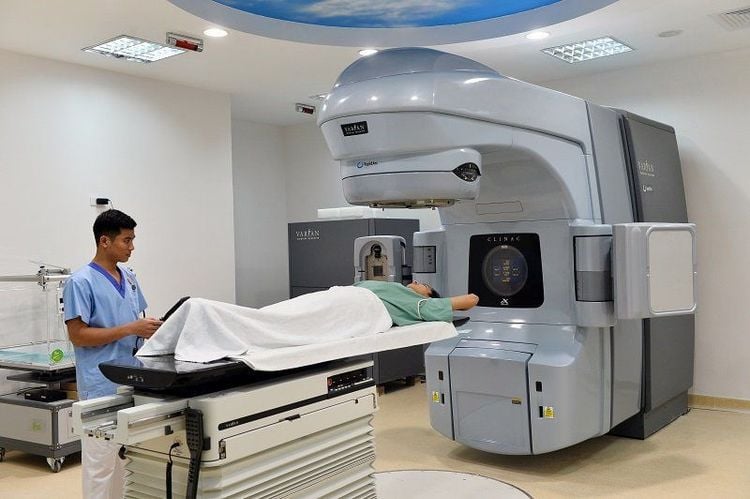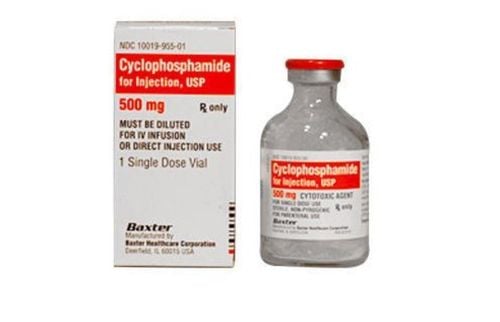This is an automatically translated article.
This article is written by doctors of Internal Oncology Department - Vinmec Times City International General Hospital.Hyperthermia or thermotherapy is a type of cancer treatment in which body tissue is exposed to high heat, intended to damage and kill cancer cells, but without causing serious damage to normal tissue. .
1. What is hyperthermia or thermotherapy?
Hyperthermia (also known as thermotherapy) is a type of cancer treatment in which body tissue is exposed to high heat. Since the 70s, many preclinical and clinical studies have shown that high temperatures (41-45 degrees Celsius) can damage and kill cancer cells, but do not cause serious damage to cancer cells. normal tissues. By killing cancer cells and damaging proteins and structures inside cells, heat therapy can shrink tumors.Hyperthermia is being studied in clinical trials, currently only applied at some cancer treatment centers in Japan, USA, Germany, China...

Hyperthermia (còn được gọi là liệu pháp nhiệt trị) đang được nghiên cứu trong các thử nghiệm lâm sàng
2. How is thermotherapy used to treat cancer?
Hyperthermia is almost always used along with other forms of cancer therapy, such as radiation and chemotherapy. Hyperthermia can make some cancer cells more sensitive to radiation or damage other cells. other cancer cells that radiation cannot damage. When combined, hyperthermia and radiation therapy are usually done at the same time. Hyperthermia may also enhance the effects of certain anti-cancer drugs.Many clinical trials have studied hyperthermia in combination with radiation and/or chemotherapy. These studies focus on the treatment of many types of cancer, including sarcoma, melanoma and cancers of the head and neck, brain, lung, esophagus, breast, bladder, rectum, liver, and appendix. , cervix and peritoneum. Many of these studies, but not all, have shown significant reductions in tumor size when hyperthermia is combined with other treatments. However, not all of these studies showed increased survival in patients receiving combination therapy.
3. What are the different methods of thermotherapy?
Several thermotherapy methods are currently being investigated, including local, regional, and whole-body hyperthermia3.1. Local Thermotherapy Heat is applied to a small area, such as a tumor, using various techniques to deliver energy aimed at heating the tumor. Different types of energy can be used like microwave, radio frequency and ultrasonic energy. Depending on the tumor location, there are several approaches to localized hyperthermia:
Outside in: used to treat tumors located within or just under the skin. An exothermic probe is placed around or near the appropriate area and energy is focused on the tumor to increase its temperature. The hyperthermia transducer is placed inside the body cavity (e.g. abdominal cavity) and helps to directly energize and heat the affected area. For example, with a brain tumor, the patient has a transducer or needle inserted into the tumor under the guidance of ultrasound, or a monitor... to make sure the probe is positioned correctly in the tumor. The heat source is then introduced into the probe. Radiofrequency ablation (RFA) is also a type of hyperthermia that uses radio waves to warm and kill cancer cells. 3.2. Regional heating Different methods can be used to heat large areas of tissue, such as a body cavity, organ, or extremity.
For tissues, deep lesions: such as cervical or bladder cancer. An external transducer is placed around the body cavity or organ to be treated, and microwave or radiofrequency energy is focused on that area to raise the temperature. Regional perfusion techniques can be used to treat cancers in the arms and legs, such as melanoma, or cancers in certain organs such as the liver or lungs. This technique sends blood out of the body, through a heating element, and then pumped (perfused) back into the limb or organ. Anti-cancer drugs are usually given during this treatment. Continuous hyperthermic peritoneal perfusion (CHPP) is a technique used to treat cancer in the abdominal cavity. peritoneal cancer including peritoneal cancer, ovarian cancer with peritoneal metastases and gastric cancer... During surgery, anti-cancer drugs are melted from a warming device through the peritoneal cavity. The temperature of the peritoneal cavity reaches 106-108°F. 3.3. Systemic heating Systemic heat is used to treat metastatic cancer that has spread throughout the body.This can be done using a number of techniques. raising the body temperature to 42 degrees Celsius, including the use of a heating chamber (similar to a large incubator) or a hot water blanket. The effectiveness of hyperthermia treatment is related to the temperature achieved during the procedure. treatment, as well as duration of treatment and cell and tissue characteristics To ensure that the desired temperature is achieved, but not exceeded, the temperature of the tumor and surrounding tissue is maintained. Monitored throughout the course of treatment for hyperthermia. Using a local anesthetic, your doctor will insert a needle or small tube with a small thermometer into the treatment area to monitor the temperature. Imaging techniques, such as CT (computed tomography), can be used to make sure the probes are in place
4. What are the complications or side effects of thermotherapy?

Tiêu chảy, buồn nôn là tác dụng phụ có thể gặp của liệu pháp nhiệt trị toàn thân
5. The prospect of thermotherapy
There are still several challenges that must be overcome before thermotherapy can be considered a standard treatment for cancer. There are currently many clinical trials underway to evaluate the effectiveness of thermotherapy. Some trials continue to study when combined with other therapies to treat different cancers. Other studies focus on improving thermotherapy techniques.In general, hyperthermia enhances the effectiveness of radiation and chemotherapy in cancer treatment and has few complications. This therapy is suitable for all disease stages, especially those with late or recurrent stage... However, further research is needed to understand the synergistic interaction between thermotherapy and radiation therapy or In addition, it is necessary to develop a unified standard for technical implementation and the sequence of this combination
Currently, Vinmec Times City Hospital has been equipped with a heating machine (Pyrexa) to apply heat therapy (regional and regional) in combination with radiotherapy and chemotherapy. Initial results showed very positive results, the patient had almost no additional side effects when combining heat therapy with radiation therapy as well as chemotherapy and immunotherapy.
Please dial HOTLINE for more information or register for an appointment HERE. Download MyVinmec app to make appointments faster and to manage your bookings easily.













